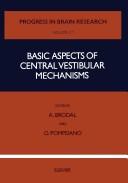| Listing 1 - 4 of 4 |
Sort by
|

ISBN: 0444410481 9786611715779 1281715778 0080861628 Year: 1972 Volume: v. 37 Publisher: Amsterdam : Elsevier,
Abstract | Keywords | Export | Availability | Bookmark
 Loading...
Loading...Choose an application
- Reference Manager
- EndNote
- RefWorks (Direct export to RefWorks)
Animal psychology and neurophysiology --- Physiology of nerves and sense organs --- Vestibular Nuclei. --- Vestibular apparatus --- -Vestibular nuclei --- -Nuclei, Vestibular --- Acoustic nerve --- Equilibrium (Physiology) --- Labyrinth (Ear) --- Schwalbe's Nucleus --- Schwalbe Nucleus --- Vestibular Nucleus, Medial --- Medial Vestibular Nucleus --- Nuclei, Vestibular --- Nucleus, Medial Vestibular --- Nucleus, Schwalbe --- Nucleus, Schwalbe's --- Schwalbes Nucleus --- Congresses --- Vestibular nuclei --- Congresses. --- -Congresses --- Vestibular Nuclei
Book
ISBN: 1635500478 9781635500479 9781597567978 1597567973 Year: 2018 Publisher: San Diego, CA : Plural Publishing Inc.,
Abstract | Keywords | Export | Availability | Bookmark
 Loading...
Loading...Choose an application
- Reference Manager
- EndNote
- RefWorks (Direct export to RefWorks)
Vestibular function tests. --- Acoustic nerve --- Vestibular nuclei --- Nuclei, Vestibular --- Vestibular apparatus --- Auditory nerve --- Eighth cranial nerve --- Nervus vestibulocochlearis --- Vestibulocochlear nerve --- Auditory pathways --- Nerves, Cranial --- Ear --- Function tests (Medicine) --- Physiology. --- Diseases --- Diagnosis
Book
ISBN: 3540068643 3642659225 3642659209 9783540068648 Year: 1974 Volume: 6 Publisher: Berlin ; New York: Springer,
Abstract | Keywords | Export | Availability | Bookmark
 Loading...
Loading...Choose an application
- Reference Manager
- EndNote
- RefWorks (Direct export to RefWorks)
Psychophysics --- Vestibule, Labyrinth --- Vestibular Nuclei --- Psychophysics. --- Vestibule, Labyrinth. --- Vestibular Nuclei. --- Schwalbe's Nucleus --- Schwalbe Nucleus --- Vestibular Nucleus, Medial --- Medial Vestibular Nucleus --- Nuclei, Vestibular --- Nucleus, Medial Vestibular --- Nucleus, Schwalbe --- Nucleus, Schwalbe's --- Schwalbes Nucleus --- Ear Vestibule --- Vestibular Labyrinth --- Vestibule of Ear --- Vestibulum Auris --- Vestibular Apparatus --- Apparatus, Vestibular --- Ear Vestibules --- Labyrinth Vestibule --- Labyrinth Vestibules --- Labyrinth, Vestibular --- Labyrinths, Vestibular --- Vestibular Labyrinths --- Vestibule, Ear --- Vestibules, Ear --- Vestibules, Labyrinth --- Psychophysic
Book
ISBN: 443199856X 4431859071 9786612069321 1282069322 443185908X Year: 2009 Publisher: Tokyo : Springer Japan,
Abstract | Keywords | Export | Availability | Bookmark
 Loading...
Loading...Choose an application
- Reference Manager
- EndNote
- RefWorks (Direct export to RefWorks)
The vestibular labyrinth consists of ? ve compartments: the lateral, anterior, and posterior semicircular canals, the utricule, and the saccule. At the beginning of the twentieth century, Robert Bárány proposed the caloric test as a clinical test of the lateral semicircular canal. This test enabled clinicians to assess the individual lateral semicircular canal function easily by using the simple method of irrigating the external ear canal with cold or warm water and observing the induced nyst- mus. We believe that the caloric test was a breakthrough in the ? eld of vestibular research. However, as far as the other compartments were concerned, there was no simple clinical test equal to the caloric test for the lateral semicircular canal function. At the end of the twentieth century, the vestibular evoked myogenic potential (VEMP) test was proposed as a new method for assessing the individual saccule function. This test has some unique attributes. First, it uses sound stimulation, even though it is a test of the vestibular system. This appears to be a contradiction n- rophysiologically. As a result, in its early stages there were controversies conce- ing the origin of the responses. However, such controversies have been overcome by basic neurophysiological studies and clinical studies. Above all, sound sensit- ity of the saccular afferents shown in cats and guinea pigs with single-unit recording methods became the main supporting evidence. Nowadays, VEMP is one of the routine clinical tests for balance disorder.
Vestibular function tests. --- Vestibular function tests --- Evoked Potentials, Auditory --- Vestibular Diseases --- Vestibular Function Tests --- Labyrinth Diseases --- Diagnostic Techniques, Otological --- Evoked Potentials --- Diagnostic Techniques and Procedures --- Nervous System Physiological Phenomena --- Electrophysiological Phenomena --- Ear Diseases --- Diagnosis --- Musculoskeletal and Neural Physiological Phenomena --- Otorhinolaryngologic Diseases --- Physiological Phenomena --- Diseases --- Phenomena and Processes --- Analytical, Diagnostic and Therapeutic Techniques and Equipment --- Otorhinolaryngology --- Medicine --- Health & Biological Sciences --- Vestibular nuclei. --- Neurology. --- Otolaryngology. --- Pediatrics. --- Paediatrics --- Pediatric medicine --- Ear, nose, and throat diseases --- ENT diseases --- Nuclei, Vestibular --- Medicine. --- Otorhinolaryngology. --- Medicine & Public Health. --- Children --- Nervous system --- Neuropsychiatry --- Health and hygiene --- Acoustic nerve --- Vestibular apparatus --- Neurology .
| Listing 1 - 4 of 4 |
Sort by
|

 Search
Search Feedback
Feedback About UniCat
About UniCat  Help
Help News
News